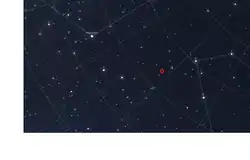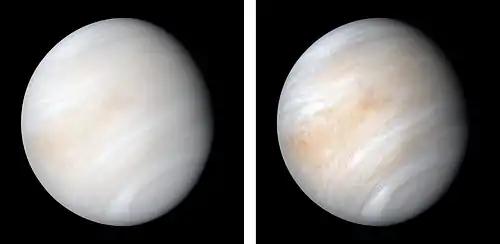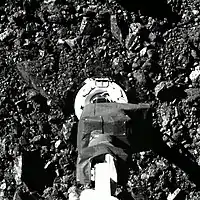HD 191939
HD 191939 is a single yellow (G-type) main-sequence star, located approximately 175 light-years away in the constellation of Draco, taking its primary name from its Henry Draper Catalogue designation.
 Location of HD 191939 in the night sky. The star is marked within the red diamond. | |
| Observation data Epoch J2000.0 Equinox J2000.0 (ICRS) | |
|---|---|
| Constellation | Draco |
| Right ascension | 20h 08m 5.75s[1] |
| Declination | +66° 51′ 2.1″[1] |
| Apparent magnitude (V) | 8.971[2] |
| Characteristics | |
| HD 191939 | |
| Evolutionary stage | main sequence star |
| Spectral type | G0V[1] or G8V[3] |
| Astrometry | |
| Radial velocity (Rv) | +9.266 ± 0.0018[1] km/s |
| Proper motion (μ) | RA: +150.256 [1] mas/yr Dec.: -63.909 [1] mas/yr |
| Parallax (π) | 18.6247 ± 0.0253[1] mas |
| Distance | 175.1 ± 0.2 ly (53.69 ± 0.07 pc) |
| Absolute magnitude (MV) | 5.32 |
| Details | |
| HD 191939 | |
| Mass | 0.92 M☉ |
| Radius | 0.945[3] R☉ |
| Luminosity (visual, LV) | 0.64 L☉ |
| Surface gravity (log g) | 4.44 cgs |
| Temperature | 5400 K |
| Metallicity [Fe/H] | -0.16 dex |
| Age | 7±3 Gyr |
| Other designations | |
HIP 99175, TYC 4244-964-1, USNO-A2 1500-07227721, 2MASS J20080574+6651019, Gaia DR2 2248126315275354496, TOI 1339 | |
| Database references | |
| SIMBAD | data |
| Exoplanet Archive | data |
| Extrasolar Planets Encyclopaedia | data |
History and nomenclature
The designation HD 191939 is from the Henry Draper Catalogue, which is based on spectral classifications made between 1911 and 1915 by Annie Jump Cannon and her co-workers, and was published between 1918 and 1924.
Characteristics
HD 191939 is a Sun-like G-type main-sequence star. It is likely older than the Sun and relatively depleted in metals.
Planetary system
In 2020, an analysis carried out by a team of astronomers led by astronomer Mariona Badenas-Agusti of the TESS project confirmed the existence of a three gas giants,[3] all smaller than Neptune, in orbit around HD 191939.
| Companion (in order from star) |
Mass | Semimajor axis (AU) |
Orbital period (days) |
Eccentricity | Inclination | Radius |
|---|---|---|---|---|---|---|
| b | ? M⊕ | 0.089 +0.010 −0.012 |
8.880411 +0.000069 −0.000069 |
0 | 88.66° | 3.37+0.13 −0.13 R⊕ |
| c | ? M⊕ | 0.178 +0.033 −0.026 |
28.58060 +0.00048 −+0.00045 |
0 | 89.14° | 3.22+0.15 −0.14 R⊕ |
| d | ? M⊕ | 0.216 +0.011 −0.011 |
38.3561 +0.0012 −0.0012 |
0 | 89.49° | 3.16+0.11 −0.11 R⊕ |
See also
- List of extrasolar planets
References
- HD 191939, entry, SIMBAD. Accessed online February 12, 2020.
- news.sky-map.org HD 191939 data
- Badenas-Agusti, Mariona; Günther, Maximilian N.; Daylan, Tansu; Mikal-Evans, Thomas; Vanderburg, Andrew; Huang, Chelsea X.; Matthews, Elisabeth; Rackham, Benjamin V.; Bieryla, Allyson; Stassun, Keivan G.; Kane, Stephen R.; Shporer, Avi; Fulton, Benjamin J.; Hill, Michelle L.; Nowak, Grzegorz; Ribas, Ignasi; Pallé, Enric; Jenkins, Jon M.; Latham, David W.; Seager, Sara; Ricker, George R.; Vanderspek, Roland K.; Winn, Joshua N.; Abril-Pla, Oriol; Collins, Karen A.; Pere Guerra Serra; Niraula, Prajwal; Rustamkulov, Zafar; Barclay, Thomas; et al. (2020). "HD 191939: Three Sub-Neptunes Transiting a Sun-like Star Only 54 pc Away". The Astronomical Journal. 160 (3): 113. arXiv:2002.03958. doi:10.3847/1538-3881/aba0b5. S2CID 211069628.


_on_Jul_14_2020_aligned_to_stars.jpg.webp)
